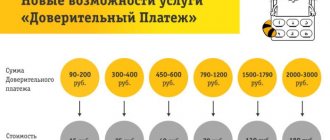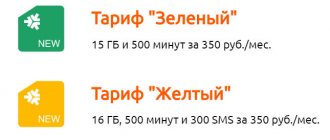Not so long ago, the mobile phone served only as a means of communication. But today, a well-known mobile operator has launched a special service for its subscribers called “Advance Account” from Beeline. With its help, mobile network clients can both transfer funds from account to account and quickly make any payment. If you use bank cards, the principle of the service will be clear.
Description of service
All subscribers with active mobile numbers in the postpaid system can use the Beeline advance account. A special advance account is an opportunity to make different categories of payments:
- transfer to the balance of other subscribers;
- transfers to bank cards, accounts, electronic wallets;
- purchases in games, virtual stores, services;
- fines, utilities;
- payment of loans;
- purchasing transport tickets;
- payment for other types of services (Internet, TV, etc.).
The advance account is replenished by the subscriber in the form of an advance payment. You can transfer money from the advance account to the main account after 4 months of using the service or upon disconnection.
Advance accounts are connected only to mobile numbers with tariffs in the postpaid system. After 4 months, the subscriber will no longer need to make an advance payment. Funds are written off in the same way as according to the tariff: the number of services and payments made during the billing period is paid.
Connecting and disconnecting
To connect an advance payment, you can use different methods. For example, enter a request in your phone consisting of numbers and symbols *110*271# and press the call key. After this, a message will be sent to the subscriber’s mobile device with the text that the service has been activated. Immediately after these steps, the client of the cellular network can begin to use it and send funds by transfer or pay for services.
This means that he can now replenish his account and make the necessary payments. You should know that the subscriber will not be able to disable such a service on his own. To do this, he needs to call the user service number by dialing the numbers 0674601 and refuse auto-replenishment.
Also, you can do it another way, without turning off anything, but simply forgetting about this one. There is no subscription fee charged to the mobile operator client for using this service, so it is not necessary to take any action to disable it.
How to replenish a special advance account?
The methods for replenishing a special Beeline advance account are the same as for replenishing a regular mobile balance. The only difference is entering the number. Instead of 9 you need to put 6 (for example: not 8-960, but 8-660). You can transfer money to an advance account from a mobile number or a bank card.
Call details on Beeline: call control in your personal account
Ways to transfer money from your main account and other payment systems:
- Bank card. Attach the card to your phone by calling 0533 . When calling, the subscriber is given a secret code, which serves as an identifier. Transfers are made via the USSD command *100*code*amount*number followed by 6#.
- Single payment card Beeline. On your mobile phone, dial USSD request *104*code from card*account number#.
Limit on expenses for using cellular communications
For the purpose of financial discipline and saving money, some enterprises set a limit that employees can “say” and which is compensated by the enterprise.
Let’s say right away that setting limits, as inspectors sometimes require, is a taxpayer’s right, not an obligation.
EXAMPLE 2. WE ESTABLISH A “CELLULAR” LIMIT
Anamit LLC has established a monthly limit on expenses for cellular communications in the context of the functionality of employees and positions: chief accountant - 1000 rubles; - accountant - 500 rubles; - head of the commercial department - 1500 rubles; - managers of the commercial department - 1000 rubles.
Thus, every month the cellular operator will credit the organization’s personal account with the required advance amount with the corresponding distribution of funds by specific telephone numbers within the limits established by the organization.
Upon reaching the established limits, the provision of communication services is suspended. Unused funds (unspoken) “burn out” in the analytics for this phone. The enterprise advance itself does not disappear. Unused company funds are carried over to the next month.
Setting certain limits for employees on cell phone expenses has its positive and negative aspects.
An important positive aspect is the discipline of employees, motivation for cost-saving measures, and reasonable moderation in conversations. And as long as the employee stays within the established limits, we see only positive factors. However, the excess of such expenses beyond the limits immediately leads to certain accounting and tax difficulties for the enterprise.
The fact is that when the limit is exceeded, communication is not always blocked. Often the excess amounts are estimated based on the results of the past time as the difference between the actual billed amounts of expenses for a specific phone and the value of the approved limit. As a result, a situation may arise where specific employees may experience overspending on cellular communications.
Read in Berator
How to take mobile phones into account
By definition, it is for these purposes that limits are introduced; they are considered non-productive and subject to compensation by the given employee.
EXAMPLE 3. ACCOUNT FOR OVEREXPENDITURE
The amount of expenses for the services of a cellular operator for the period amounted to 18,172 rubles.
excluding VAT. At the same time, excess amounts of expenses for cellular communications were revealed - only 4728 rubles, including: - according to A. P. Mironov - 4230 rubles, - according to M. A. Belina - 498 rubles. At the same time, A. P. Mironov He compensated for these funds, deposited them into the company’s cash register, but M.A. Belina was unable to retain them, since the employee had already quit. DEBIT 26 “General business expenses” CREDIT 60 “Settlements with suppliers and contractors”
- 13,444 rubles.
(18,172 rubles – 4,728 rubles) – expenses for payment for cellular communication services for the reporting period are reflected within the limits established by the enterprise; DEBIT 73-2 “Settlements for compensation of material damage” CREDIT 60 “Settlements with suppliers and contractors”
- 4728 rubles.
– amounts of excess communication expenses are allocated to the relevant employees of the enterprise; DEBIT 50 “Cash” CREDIT 73-2 “Calculations for compensation of material damage”
- 4230 rubles.
– above-limit communication expenses were compensated by the employee Mironov A.P. DEBIT 91 “Other expenses” CREDIT 73-2 “Calculations for compensation of material damage”
- 498 rubles. – excess communication expenses for M.A. Belina were written off as losses due to the impossibility of deducting them.
If an employee compensates for expenses above the limit, then personal income tax and insurance premiums do not arise, since there is no personal income. But if it was not possible to collect these amounts or the company decided to reward the employee in this way, then it turns out that it is necessary to withhold personal income tax from the employee (notify the tax office no later than March 1 of the year following the expired tax period in which the relevant circumstances arose). authority about the impossibility of deduction) and charge insurance premiums (letter of the Ministry of Finance of Russia dated October 13, 2010 No. 03-03-06/2/178).
Further, the amount exceeding the limit of expenses for the use of cellular communications, withheld from employees’ wages, as well as contributed by employees to the organization’s cash desk, is taken into account as part of the enterprise’s income (letter of the Ministry of Finance of Russia dated November 26, 2015 No. 03-11-06/2/68878, dated July 27 .2006 No. 03-03-04/3/15).
There will be no need to charge VAT on these amounts, but you will have to restore the tax that was deducted when making payments to the budget.
VAT is not deductible and is written off from the organization’s own funds. EXAMPLE 4. RESTORING VAT
AllianceCenter LLC received documents from a cellular operator confirming communication expenses incurred in the reporting month in the amount of 17,121.80 rubles, including VAT of 2,611.80 rubles. However, expenses in the amount of 5,121.79 rubles ., including VAT of 781.29 rubles, were recognized as over-limit, and therefore non-productive.
Reflection of VAT write-off on above-limit communication expenses in accounting will depend on whether this VAT was deducted in settlements with the budget. If VAT is still listed on account 19 “Value added tax on acquired assets”: DEBIT 91 “Other expenses” CREDIT 19 “Value added tax on acquired assets”
- 781.29 rubles.
– VAT on non-productive expenses for cellular communication services is written off as other expenses of the organization without reducing the taxable base for income tax. If VAT was deducted in settlements with the budget and its restoration is required: DEBIT 91 “Other expenses” CREDIT 68 subaccount “Settlements with budget for VAT"
- 781.29 rubles. – VAT on non-productive expenses for cellular communication services has been restored without reducing the tax base for income tax.
But is such a procedure necessary in relation to income tax and VAT in all cases? No, not necessarily. If the employee has gone beyond the limit, then this is still not an absolute factor that the expenses are non-productive.
It is quite possible that there is an objective reason for overspending on telephone calls this month. In this case, based on the employee’s explanatory note (memo), the limit can be increased (one-time or on an ongoing basis). In this case, these amounts will be production costs and there will be no need for VAT.
Holding techniques
If the income tax and VAT are quite clear, then the situation with withholding these amounts from the employee is quite complicated. The grounds for withholding amounts from wages are listed in Article 137 of the Labor Code of the Russian Federation. And let's start with the fact that labor legislation does not provide for deductions from wages on such a basis as compensation for cellular communications expenses.
Some experts propose to classify an enterprise's excess communication expenses as direct actual damage (Article 238 of the Labor Code of the Russian Federation). This is the only problem that may arise. After all, you cannot simply declare that the enterprise has suffered damage; it must be proven and a number of procedural measures must be carried out (damage assessment, written recording of damage, the presence of an explanatory statement from the employee and the decision of the manager). But even in this case, there is a high probability that the employee will refuse to voluntarily reimburse these amounts and will have to go to court, which the company will most likely lose.
Let us explain our opinion in more detail. We repeat that damage must be proven. And in this case, the presence at the enterprise of an order on certain limits will not play any role at all. The administration will have to prove not that the limit was exceeded, but that specific telephone conversations were not carried out for production reasons. And it’s good if such numbers and amounts are highlighted and easy to establish.
But most often the details contain a large number of telephone numbers with which connections were made. And it is very difficult to immediately determine whether these are production or non-production contacts. And the employee’s explanatory note will indicate, for example, that he made calls to potential clients according to data from various Internet resources. And it will be very difficult to prove that such and such a phone belongs to a friend of the employee, and not to a representative of a client.
Thus, bringing the matter to a successful conclusion strictly within the official framework will be very difficult.
Here administrative resources can come to the aid of the employer, including the possibility (if available) of adjusting the employee’s bonus. This is perhaps the most convenient option for resolving a difficult situation.
But, in our opinion, the following method of compensating for “cellular” expenses will be optimal. This way, the company is deprived of input VAT, but avoids many of the problems that arise with over-limit payments.
When is prepayment not possible?
There are categories of goods for which advance payment is prohibited. They are listed in Order of the Government of the Russian Federation No. 21-r dated January 16, 2018 and are intended for mass consumption.
This list includes products for 22 OKPD2 items. Among them are such products as:
- some types of linen, clothing, curtains, carpets;
- some types of stationery;
- some types of vehicles;
- some types of computers, television and radio receivers;
- and etc.
Also, Order No. 21-provides a list of services for which advance payment is not possible. Basically, these are repair services for certain groups of machinery and equipment, furniture and household items:
To find out how to receive tenders with advance payment: write to us or just call: 8
Advantages and disadvantages
It is difficult for customers to decide to conduct auctions with advance payment, since this point has not only a positive, but also a negative side.
Undoubtedly, for the contractor such a contract will be extremely profitable, because it becomes possible to think through the work plan in advance and agree with the subcontractor on the supply of the necessary materials or products. The contractor who has received an advance payment does not spend his own money on the purchase of consumables, which is very convenient and saves his budget, which can be used to solve other problems.
Tender support services from professionals
Protection from RNP, Exception from RNP, Complaint to the FAS, Turnkey tender support, Preparation of an application for a tender of any complexity, Development of technical specifications for 44 and 223-FZ, Analytics and audit, Personal training in government procurement
To get a consultation
The disadvantages of pre-payment for work include the increased risk of non-fulfillment of the contract. For example, an unscrupulous supplier may receive 100% prepayment under the contract, but fail to fulfill its obligations. The failed work was paid in full, and this may influence the violator’s decision to evade liability.
For such guilty persons, the legislation provides for measures in the form of accrual of penalties, fines and the inclusion of information about them in the register of unscrupulous suppliers (RNP).
New rules and clarifications for advances 44-FZ
From 01.07.2020, amendments to 44-FZ, introduced by 124-FZ dated 04.24.2020, began to work. The innovation was due to the fact that now the security for the execution of the contract should be calculated based on the NMC of the contract, if the advance is provided with treasury support. In this case, the NMCC is reduced by the amount of the prepayment.
And if we talk about bidding for representatives of the SMP, then the contract price is reduced by the amount of the advance payment (clause 1, part 1, article 30 of 44-FZ).
The condition of advance payment of work is considered essential, and according to the new rules it is allowed to change it. This is permitted in some cases, the list of which is set out in Letter of the Ministry of Finance No. 09-04-05/41434 dated May 19, 2020. It is possible to change the essential condition for advance payment only if these measures are simultaneously observed:
- the new prepayment amount does not exceed the maximum amount allowed by law for these works. For example, advance payments under a contract for the construction of regional and municipal facilities (if funds come from the federal budget) do not exceed 50% of its amount;
- the condition for advance payment is included in the text of the contract;
- the initiator of the proposal is the contractor, and adjustments are made in agreement with the customer;
- The contract could not be implemented due to reasons related to the coronavirus.
Supply of computers with advance payment:
In March 2021, Government Order No. 761-r dated March 27, 2020 was posted on the official website of legal information. According to it, advance bidding under 44-FZ is now permitted for the purchase of domestic PCs weighing no more than 10 kg (tablets, laptops), phones , televisions, radiotelephone and radiotelegraph communication equipment, video communications, which until this moment were subject to a ban.
Important point! Domestic equipment is equipment contained in the unified register of radio-electronic goods.
Results
Currently, it is impossible for organizations to carry out activities without communication services, which can be expressed by working with Internet resources, as well as the use of mobile and landline communications.
The reflection of these services in accounting and the procedure for their taxation depend on the purpose of their use and documentation. You can find more complete information on the topic in ConsultantPlus. Free trial access to the system for 2 days.
Closing checks
According to changes in 54-FZ, from July 1, 2021, it is necessary to generate cash receipts for offset, as well as refund of payment (prepayment). If the client does not receive a product or service at the time of payment, two checks must be generated: the first - at the time of payment, the second - when the goods are shipped or the service is performed.
Let's figure out the order in which checks for advance payments and prepayment offsets are generated, as well as checks that cover settlement data.
How to work with advances and prepayments
According to table. 28 of Appendix No. 2 to the Federal Tax Service order No. MMV-7-20/ [email protected] , there are several options for prepayment with the corresponding characteristics of the payment method:
- 100% advance payment – full advance payment, which is made by the client before receiving the goods (rendering the service);
- prepayment – partial advance payment, which is made by the client before receiving the goods (rendering the service);
- advance payment – prepayment in cases where the list of goods/works/services cannot be determined in advance.
Full payment occurs upon full payment (also taking into account advance and prepayment) at the time the client receives the goods/services.
Thus, when an advance payment or advance is received, the cash register user generates a check with one of the three corresponding indicators of the payment method (“Advance payment 100%”, “Advance payment” or “Advance”). When shipping goods or performing services - a closing receipt with the payment method sign “Full payment”. The last sign does not have to be indicated in the printed form of the receipt issued upon shipment.
If the client first made an advance payment, and the seller provided a loan for the remaining amount, you need to run at least three checks (letter of the Federal Tax Service dated February 20, 2019 No. ED-4-20/2929). They are formed with the following characteristics:
- “PARTIAL PAYMENT AND CREDIT” – in case of partial payment with the transfer of goods and its subsequent payment on credit;
- “TRANSFER ON CREDIT” – when transferring goods without payment with subsequent payment on credit;
- “CREDIT PAYMENT” – when paying for goods after they have been transferred.
When the last loan payment is made, a check is generated that covers the payment details.
Delivery costs may be included in the prepayment. Or the buyer organizes delivery on his own if he bears these costs.
If the buyer wants to return the prepayment or advance payment, the seller needs to punch out a cash receipt with the calculation attribute “Return of receipt”. When returning a prepayment or advance payment, the client must fill out a statement, which must indicate his full name, passport details and the reason for the return.
When and who generates checks for prepayment offset and upon shipment
The client transfers money to the supplier's bank account
In this case, the required amount is not credited immediately, but after some time. Therefore, when making an advance payment, questions arise: when is it necessary to generate a check for the advance payment? When was the money transferred or when did it reach the seller’s account?
According to clause 5.4 of Art. 1.2 54-FZ, for non-cash payments, a cash receipt can be generated no later than the business day following the day of settlement, but no later than the moment of transfer of the goods. The supplier can find out about the receipt of the advance from the bank statement, which is available for viewing the next day after the money is credited to the account. This way he will identify the client with his order and will be able to generate a receipt. These actions do not violate the requirements of the law.
The seller transfers the goods to the courier service for delivery to the buyer
In this situation, the prepayment receipt is generated by the supplier. However, the question arises: who is obliged to punch the receipt for shipment - the seller or the courier?
Issuing a receipt for the transfer of goods is the responsibility of the courier service, since the cash register must be used by the person making payments to the buyer (clause 1 of Article 4.3 of 54-FZ). Since the transfer of the order against the prepayment is related to settlements and this is done by the courier, it is he who must punch the cash register receipt.
However, most often, the closing receipt is generated by the seller when transferring the goods to the courier. It is then either sent to the client electronically or transmitted via courier in paper form.
Checks for advance and prepayment: what is the difference
The seller gives two checks to the buyer if he pays in advance, before actually receiving the goods. In this case, the first check is issued when the customer makes an advance payment, and the second check is issued when he receives the goods.
There is a difference between prepayment and advance payment; accordingly, checks for advance payment and prepayment are also different. Advance
recognize the transfer of money before the actual receipt of the goods or services.
Prepayment
can be partial or full; it, like an advance payment, is made before the goods are issued or the service is received.
The seller indicates the “Advance”
in the receipt if the client has not yet fully decided on the choice of product or service. In this case, the attribute of the item is not indicated.
"Prepayment"
it is assigned in the case when the buyer knows exactly what product he is purchasing or what service he is going to use. The receipt indicates the exact name of the purchased product or service.
How to issue a check for an advance or prepayment: an example of a check
Issuing a check for an advance or prepayment is almost identical, except for what sign is indicated. The seller punches the first check at the moment when the buyer gives him the money: either part or the full amount (with 100% prepayment).
The second check is issued upon actual receipt of the goods or services by the client. At the same time, he indicates the sign “full payment”. The amount must indicate that an advance or prepayment was made.
Important:
the name of the product or service must be present in the second check, even if it was not indicated in the first (because an advance was made).
When one check is used for all advances
In some cases, both organizations and individual entrepreneurs may not punch a check for each advance payment or advance. They can take advantage of the relaxation of writing one check for all advances. But only taxpayers of a limited range of activities can do this:
- holding cultural events;
- transportation of passengers, luggage, cargo and cargo luggage;
- provision of communication services;
- provision of electronic services listed in Art. 174.2 Tax Code of the Russian Federation;
- services of management and resource supply organizations;
- provision of security services and security systems;
- services of educational organizations.
One check for all advances is issued at the end of the billing period during which she accepted these advances. After the end of the billing period, the organization has another 10 days to process the check.
Advance payment for online purchases
If payment is made non-cash via the Internet, the seller is not required to issue a paper check. He sends the client a copy of the fiscal document, for example, by email.
The online service “Astral.OFD” is suitable for transmitting fiscal data in accordance with the new procedure for using cash register equipment. In addition, the service provides additional functions, such as monitoring of retail outlets, analytics of fiscal data and sending receipts via SMS and email.











